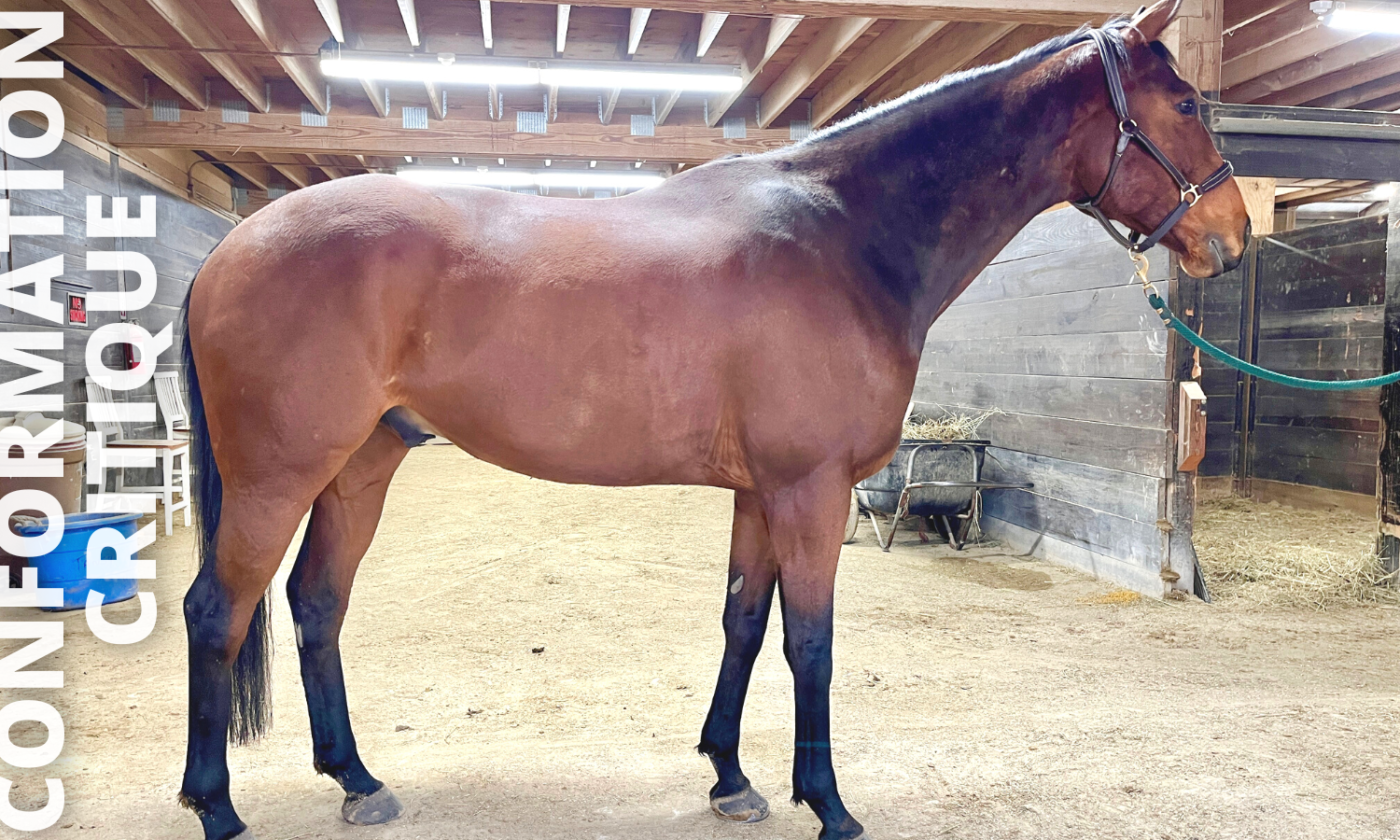Renew Your USEA Membership for the 2023 Season Today LEARN MORE

Have you ever wanted to look through the judge’s eyes and see what they see when evaluating a horse's conformation? Now is your chance! Using only a photo, video, and information on age and breed, legendary horseman and past USEA Young Event Horse Championship judge Chris Ryan is sharing his insights into equine conformation in our Conformation Critique article series.
First Impression
As a selector in the Gorsebridge Go for Gold Event Horse Sale, we can have over 300 horses coming at us during the selection days. A standard routine is needed which does not change. My first question is, "Has the horse quality?" By quality, I mean Thoroughbred % or Thoroughbred influence. I’m convinced the Thoroughbred influence brings "forward thinking" to the individual—so important in the performance horse. I reckon a Thoroughbred looks into the distance and his horizon is way out there and knows he can get there. The horse that lacks this influence has their horizon right in front of his nose, or worse still behind him.
In those lacking, their DNA has the lion right behind them, and don’t possess enough gallop to get away (subjective opinion). To complicate matters, there is a relatively new type I see nowadays. He has been described as "faux" (false) blood. They look like they have the Thoroughbred qualities of refinement but are unable to make cross-country times easily. The giveaway can be big, thick, heavy tail hair. It is rare to see a Thoroughbred with this. Now, onto business!
This horse, Kip Seven, is stood up very well in an open stance which facilitates a conformation assessment and shows him to the best effect. The camera is held a little low which possibly accentuates the horse's height and the point at which the shoulder comes into the withers. No worries, as the stance is great!
Conformation
This horse has good length, depth, and back end. Good connections head-to-neck and neck-to-shoulder should lead to an uphill balance. A low-set neck can have the horse naturally on the forehand. He has a lovely muscled top line. Look at the muscling on the crest and over the loins. His producer has him working in a super outline and that uphill balance surely helps. Great power in the "backend" (quarters, second thigh, and angle of a well-formed hock), the real engine when combined with the Thoroughbred heart and lung function. He has a sloping shoulder which should allow a very good length of stride. Kip Seven is not over short coupled nor too long, he stands with the hind leg well placed under him, again explaining that lovely muscling over the loins. He should be well engaged in motion. The cannons are a fraction long and bone quite light. However, Thoroughbred bone can be like tempered steel like the trotting horses. Good 45-degree pastern angle. Now the feet. Are they a pair? The near looks to have less angle and possibly less heel.
Movement
Kip Seven possesses a huge walk stride from the first step. Look where he puts his hind leg! There’s nearly 12" of an overtrack. This should transfer to great engagement in the upwards and downwards transitions and the ability to shorten his stride on approach to a fence. I love a horse whose walk really gets you there, and that four-time beat usually leads to a great gallop (also four times). I wonder does he pull off his front shoes with his hind? I noticed in the photo that he is unshod behind.
Overall Assessment
This horse has some of the best of the Thoroughbred qualities with great conformation and movement. He is in very good hands with such a developed topline. As in the previous article, I’d prefer the handler to turn the horse away from himself when turning in hand as it puts the inside hind leg nicely under him and also prevents the handler from getting in front of the shoulder. The horse is a lovely type. I love his curious look at the cat in the corner at the walk. Thoroughbreds don’t miss a trick!
Interested in submitting your horse to be critiqued? Send your high-resolution conformation photos and video to Meagan DeLisle at mdelisle@useventing.com for your chance to be featured.
About Chris Ryan
Chris Ryan comes from one of the most storied families in Ireland. Following in his father’s footsteps, Ryan hunted the legendary Scarteen hounds for 28 seasons. The Scarteen hounds have been in the Ryan family for more than 400 years. From racing in his youth, to huntsman, and now judge and commentator, Ryan has become a regular part of eventing life in Ireland and Europe. One of the foundation selectors of the Goresbridge Go for Gold elite event horse sale held every November in Wexford, Ryan has developed a keen eye for young stock, many having gone on to great things in Ireland, England, and Europe. He is best known in the United States for finding McKinlaigh, the horse with whom Gina Miles won the individual silver medal at the 2008 Beijing Olympic Games, and producing him from a 3-year-old to a 5-year-old at his first Preliminary level event. International winning and placed horses including Copper Beach, Cooley Rourkes Drift, Cooley SRS, November Night, Prince Mayo, Glencento, Reenmore Duke, Ballymurphy Mark, and many others all came under his eye and passed the test. All this experience is blended with an instinct for what is required and the genetics to operate at the highest level.